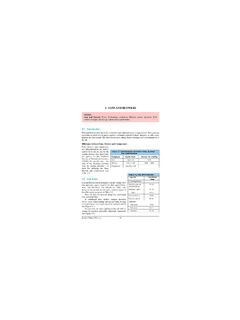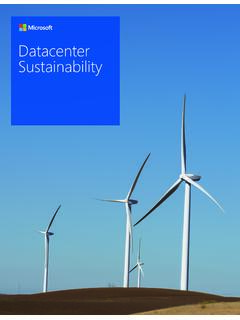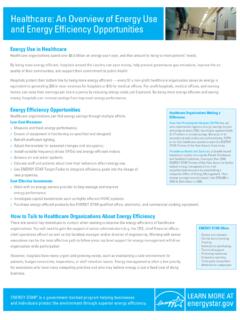Transcription of Carbon Efficiency, Carbon Reduction Potential, and ...
1 Carbon efficiency , Carbon Reduction potential , and economic development in the People's Republic of China: A Total Factor Production Model Carbon intensity is the traditional measure of an economy's Carbon performance. However, it is incapable of capturing the multidimensional features of an economy's Carbon performance, particularly when increased emissions have causes other than poor emitting technology, such as changes in the energy mix or the substitution of energy for labor. Hence, it can sometimes be a poor yardstick for comparing countries with different natural resources or factors of production. Introducing the concept of Carbon efficiency , . based on Data Envelopment Analysis, this study calculates the Carbon performance in 2005 of 29 regions in the People's Republic of China with results different from what the Carbon intensity indicator would have suggested: Better Carbon performance is associated with higher levels of economic development and greater resource endowments.
2 About the Asian development Bank ADB's vision is an Asia and Pacific region free of poverty. Its mission is to help its developing member countries substantially reduce poverty and improve the quality of life of their people. Despite the region's many successes, it remains home to two-thirds of the world's poor: billion people who live on less than $2 a day, with 903 million struggling on less than $ a day. ADB is committed to reducing poverty through inclusive economic growth, environmentally sustainable growth, and regional integration. Based in Manila, ADB is owned by 67 members, including 48 from the region. Its main instruments for helping its developing member countries are policy dialogue, loans, equity investments, guarantees, grants, and technical assistance. Asian development Bank 6 ADB Avenue, Mandaluyong City 1550 Metro Manila, Philippines ISBN 978-92-9092-032-8. Publication Stock No. RPT101860 Printed in the Philippines 1 6/22/2010 4:13:58 PM.
3 Carbon efficiency , Carbon Reduction potential , and economic development in the People's Republic of China A Total Factor Production Model Hongliang Yang 2010 Asian development Bank All rights reserved. Published 2010. Printed in the Philippines ISBN 978-92-9092-032-8. Publication Stock No. RPT101860. Cataloging-in-Publication Data Hongliang Yang Carbon efficiency , Carbon Reduction potential , and economic development in the People's Republic of China: A total factor production model Mandaluyong City, Philippines: Asian development Bank, 2010. 1. Carbon efficiency . 2. Climate change. 3. economic development . 4. People's Republic of China. I. Asian development Bank. The views expressed in this publication are those of the authors and do not necessarily reflect the views and policies of the Asian development Bank (ADB) or its Board of Governors or the governments they represent. ADB does not guarantee the accuracy of the data included in this publication and accepts no responsibility for any consequence of their use.
4 By making any designation of or reference to a particular territory or geographic area, or by using the term country in this document, ADB does not intend to make any judgments as to the legal or other status of any territory or area. ADB encourages printing or copying information exclusively for personal and noncommercial use with proper acknowledgment of ADB. Users are restricted from reselling, redistributing, or creating derivative works for commercial purposes without the express, written consent of ADB. Note: In this report, $ refers to US dollars. Asian development Bank 6 ADB Avenue, Mandaluyong City 1550 Metro Manila, Philippines Tel +63 2 632 4444. Fax +63 2 636 2444. Hongliang Yang Corresponding author For orders, please contact: Tel.: +63 2 6326830. Department of External Relations Fax: +63 2 6362302. Fax +63 2 636 2648 E-mail address: Contents Abstract iv Abbreviations iv Introduction 1.
5 Research Methodology 3. Literature Review 3. Data Envelopment Analysis and Input Slack 4. DEA-Based Model for economic Energy Environment Performance 5. Carbon efficiency 6. Carbon Reduction potential 6. Modified Carbon Intensity (MCI) 6. Research Data 7. Empirical Study and Results 8. Carbon efficiency 8. Carbon Reduction potential 8. Carbon efficiency and economic development 10. Conclusions and Policy Suggestions 12. References 14. iii Abstract The most commonly used measure of the Carbon performance of an economy is Carbon intensity ( Carbon dioxide per gross domestic product [CO2 /GDP]). As an indicator, it is easy to understand and use, but it has serious limitations. First, it is incapable of capturing the multidimensional features of an economy's Carbon performance, as economies are endowed with different natural resources and factors of production. Second, it cannot measure the substitution effects between energy and other factors.
6 It may increase solely because energy is substituting for labor, rather than due to any underlying deterioration in emitting technology. This can happen in any modernization process of any economy. Other factors, such as changes in the energy mix or sectoral changes in an economy, can also cause movements in Carbon intensity that do not represent actual changes in Carbon performance. This paper therefore suggests that we consider economy-wide Carbon performance from a total factor production perspective. Based on the lessons learned from the efficiency analysis literature, this paper proposes a new approach that relies on a Data Envelopment Analysis (DEA) . based model. The paper presents the findings of an empirical study that was conducted using provincial-level data from the People's Republic of China in 2005. The findings not only contribute to the research methodology, but may also have important implications for national and international climate change policies.
7 Key words: Carbon efficiency , Carbon Reduction potential , economic development Abbreviations CNY yuan CO2 Carbon dioxide DEA Data Envelopment Analysis DMU decision-making unit GDP gross domestic product MCI Modified Carbon Intensity PRC People's Republic of China iv Introduction The People's Republic of China (PRC) is the world's second-largest energy consumer after the United States and has one of the world's fastest-growing energy sectors. While energy fuels economic growth and poverty Reduction , inefficient energy use accelerates resource depletion and severely damages the environment. It is hard to reconcile continued energy consumption growth with environmental sustainability. The government has made great efforts to improve energy efficiency and reduce Carbon dioxide (CO2) emissions. For example, its Eleventh Five-Year Plan (2006 2010) mandates a 20% Reduction by 2010 in the energy intensity,1.
8 Which has been allocated to the provinces, autonomous regions, and municipalities. The government has earmarked 10 key industries for energy savings, and has placed under tight supervision 1,000 energy-intensive enterprises. In 2006, the government introduced its National Evaluation Report on Climate Change, which included plans to develop a low- Carbon economy. In September 2007, the government declared that the PRC would promote a low- Carbon economy by improving energy efficiency , developing low- Carbon energy technology, expanding Carbon sinks,2 and developing renewable In November 2009, the government announced that it would reduce by 2020 the PRC's Carbon intensity4 by 40% 45% from the level in These steps have been recognized as signs of a strong political commitment by the government to developing a low- Carbon economy. Combating climate change requires the international community to work together to reduce the total amount of CO2 emissions globally, ultimately stabilizing its atmospheric concentration at a level that would prevent dangerous anthropogenic interference with the climate system.
9 Achieving this target would require great improvements in the Carbon performance of all economies. However, despite continuing interest among academics and policy makers, there have been few in-depth examinations of economy-wide Carbon performance. Currently, the most commonly used measure of an economy's Carbon performance is Carbon intensity, an indicator that is easy to understand and use, but that has many serious limitations. First, Carbon intensity is incapable of capturing multidimensional features of an economy's Carbon performance. As stipulated in the Copenhagen Accord, combating climate change needs to be considered on the basis of equity and in the context of sustainable development (para. 1, Copenhagen Accord, 2009). In most countries, CO2 emissions come mainly from the consumption of fossil energy. However, energy alone cannot produce anything; it must be combined with other factors of production, such as capital and labor, to produce output.
10 Countries are at different stages of development , and 1. The amount of energy consumed per unit of gross domestic product (GDP). 2. A Carbon sink is a natural or artificial feature, such as a forest, that absorbs and stores Carbon , thereby removing it from the atmosphere. 3. President Hu Jintao made this declaration at the 15th Asia-Pacific economic Cooperation conference in Sydney, Australia on 8 September 2007. 4. The amount of Carbon emitted per unit of GDP. 5. The announcement was made on 26 November 2009 as a sign of the PRC's commitment to addressing global climate change. 1. Carbon efficiency , Carbon Reduction potential , and economic development in the People's Republic of China: A Total Factor Production Model they are endowed with different natural resources meaningless yardstick for comparing mitigation and factors of production. They therefore take and adaptation activities across countries.















